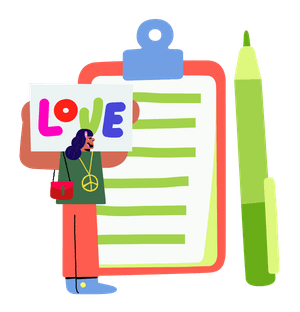Article Writing: How you learn more from yourself than from reading a book part 2/2
Ronny Schreiber · March 30, 2022
This is the second of my series of articles to motivate you to write.
The first part was about the benefits you can experience while writing like:
- Opinion forming
- Building skills in writing
- Structuring and summarizing topics
- Positive feelings during and after finishing an article
- Reactions to your written thoughts Feel free to read again and let yourself be convinced.
Furthermore, we dealt with the different phases of writing, which we will continue today. Therefore, this article is about how to start writing. How to get a structured and regular way of working from idea generation, research, brief, outline, the writing itself, reviewing the article, and much more.
In addition, you will find a writing template that will help you ask the right questions when researching your article. Also some helpful tips on how to get better and stay on top of the writing process.
How to start writing
You have now set yourself the goal of writing an article. But the blank page may intimidate you. So how do you start? Everyone ticks differently and finds their own way. But, I can give you some guidance here that has helped me. You don't need any basic requirements. To get a first feeling for how and what you want to write, start by reading other people's articles. Discover what you like and what you want to include in your article.

Illustration by Cezar Berje
Collect ideas and learning goals
First, you need inspiration for what you want to write about. Is there a topic that you are currently working on or a problem you are having? Start with a rough collection of ideas. Sift through them to find subjects that matter to you or that you can learn something from. It's easier to write down and motivating. It will help you stay on the ball later. Also, get feedback from others on your initial ideas for relevance and potential.
A structured approach to writing
The best way to write an article is to take a step-by-step approach. After you discover your topic, explore it. For instance, I am using a simple writing template to help me with this, which I would like to share with you:
- Write a Brief
- Define Outline
- Writing
- Editing
Brief
In the first phase, you approach the theme roughly. You do research and ask yourself questions about your topic. The answers will help you in many ways:
- You explore your motivation.
- You find references to other articles to get closer to the subject.
- You find out what questions are asked in the community about the topic.
- You make the thoughts into your key ideas. You come up with a catchy title.
Think about who your target audience is. Set a goal what do you want your readers to have learned after reading. Determine how many words you want to use and which ones are most important. If the article is more technical, describe which tech stack you will use. You explore what kind of example project you can use to illustrate your explanations to the reader.
Writing template
| Topic | What is the topic you want to deal with in your article? |
| Motivation | What is your reason for writing about it? Why should your readers want to know about it? Why is it important, why is it relevant? |
| Documentation / References | What documentation already exists on this topic? What are other people writing about it and what do they think about it? Gather links to formal and informal documentation. Add inspirational links to articles/tutorials others have written on this topic. What do you like or dislike about these? |
| Questions | What questions are people asking about this topic? On Stack Overflow or other developer platforms? On forums related to your topic? What questions are coming up under competitor articles? What is trending about it on Twitter, Reddit, Slack? How is the topic being talked about in your own organization? What questions did you have before you finally understood it...? |
| Key Ideas and Concepts | What are the main ideas? What concepts will you include? What techniques will you cover? |
| Title | Come up with a catchy and informative title. What would you search for to look for your article? What would appeal to you if you saw your title? |
| Audience Level | What assumptions do you make about your audience before they read this? Who is the article aimed at and for what reasons? |
| Learning Goal | What is the unique learning objective of your article? What will the audience learn while reading the article? How will you improve their lives? |
| Target word count | Think about the length of your article in advance and set a target. |
| Keywords/Tags | What are the important keywords in your article? What search terms would you use to find answers to your topic. |
| Techstack | If it is a technical article, what technology do you use? |
| Sample Project | What kind of example project can you create to better illustrate your point? Readers will engage better with your concept if they apply what they learn themselves. |
At the end of the brief when you have answered the questions for yourself, you will have a solid foundation to move on to the next phase.
Define Outline
Now it's time to give your article a structure. It is important to pay attention to the three main sections of your article: beginning, middle, and end.
- In the beginning section, think about how you want to introduce the topic. For example, you can challenge the reader, give him a summary, or explain what he will learn from reading your article.
- The middle section is designed variably. You can describe your theory on a higher level, illustrate your theory or even go deeper into the topic. You can also work with references that support your story to back it up. Or give examples in your reference that illustrate options or that you don't want to go into. Another part can be instructions. Where you explore clear step-by-step instructions for the reader. Illustrate them with clear examples or add code samples.
- In the end section, which is at least as important, you have the chance to provide the reader with material. You give a summary of the entire topic, offer sources for further reading, or even encourage clear action.
At the end of this step, you have divided your article into small sections. You've put them together logically and thought about how you're going to make the reader understand each part.
WritiNG
Now it becomes more concrete. You now give depth to your structure elements. I found the bullet point technique very helpful. In this technique, you first write down bullet points for the individual parts of your article. Once you have structured this for the entire article, you go one level deeper. You add another level of bullet points in which you describe the parent elements in more detail. You can do this in different depths depending on your needs. In the end, the individual sections will be clearer for you. You will have captured the important information for the respective section.
- Major Point 1
- Minor Point 1
- Supporting Point 1
- Supporting Point 2
- Supporting Point 3
- Minor Point 2
- Supporting Point 1
Now it's time to formulate your key points. You can assemble the individual building blocks into sentences and paragraphs. Do this bit by bit. Let your thoughts run free and concentrate only on writing. Don't mix editing and writing because it will interfere with your creative process.

Illustration by Cezar Berje
Editing
Now that you have written your complete article once, the work is not yet completely done. You should now deal with it again and revise the individual sections. The point is to put the finishing touches on your article. Make sure your sentences are short and your language clear. Correct paragraphs that do not belong together.
- Use headlines and sub-headlines
- Highlight the important parts of the text
- Define illustrations
- Create lists to keep your article interesting You generally check the tone of your article and whether it has achieved the goal you set for it.
When you're happy with your article, you're done, but don't miss the chance to get feedback from others who may be more experienced in writing or can give you tips on your topic. After that, you are ready to publish.
Useful tips
I have some useful tips that can help you. In writing itself, in motivation, or in building knowledge in the field of writing or revision.
Fixed time slot per week
To keep your goal in mind, it is helpful to develop a routine for your writing behavior. I, for example, always have a blocker of 25 minutes on Friday mornings. In which I take time to write my current article. That's enough to keep the topic in my head again and again. And yes, it's not always easy for me to motivate myself, sometimes I'm not in the mood. But if I sit down, I always get into it well and manage to develop my article further. Even if it's just a few text corrections.
Writing Buddy
Like so many things, writing is more fun together. I recommend you to find someone who shares your passion, whether in a company or among friends. With him or her, you can check your progress together and motivate each other for the next steps. Of course, the person is also someone who can support you in your work. The writing buddy can give you feedback or share new thoughts with you.

Illustration by Cezar Berje
Tools for self control
No writer has ever fallen from the sky, so don't expect your first article to be an instant masterpiece. To improve your text and develop your writing style, tools can help you. For example, Grammarly is a great way to identify alternative words and phrases. Hemingway helps you to identify complicated sentences. Try these tools when you have finished writing a part of your article and improve yourself.
Learning together
A good starting point for your writing activities can also be a workshop. In which you take your first steps in a group. There you will find people with the same goal. You will also find an experienced teacher who can give you important tips for writing. I enjoyed such an experience very much. It encouraged me to express myself with the tools I was given and to dare to write in a structured way.
Summary
With a step-by-step and structured approach, you can make your article a reality. Keep motivating yourself and get good results.
So get to work, begin brainstorming on the topics you're passionate about, and start writing your article. Use the writing template for the preliminary work and use the individual phases of writing.
Anyone can write. Says the guy who also tries it out. ;)
If you haven't read enough on the subject of writing, go ahead and read part three. There I'll explore the topic of feedback and describe how we do mob writing and use git to write our articles.
Links
- Grammarly and Hemingway are great tools to improve writing style
- An awesome workshop instructor Lea Marolt Sonnenschein
- Illustration by Cezar Berje
Ronny Schreiber
